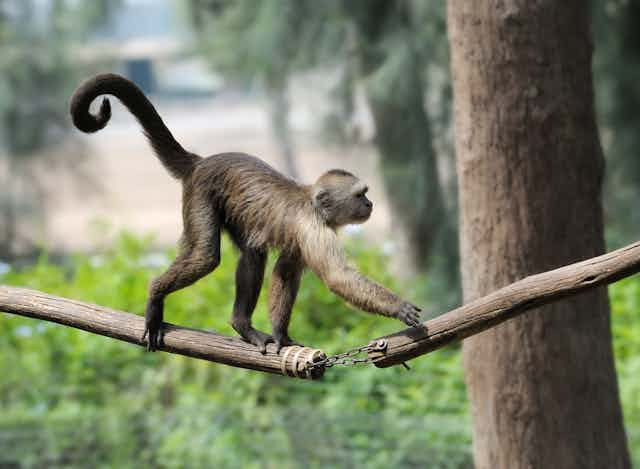Put the word “evolution” into Google images and the results are largely variations on one theme: Ralph Zallinger’s illustration, March of Progress. Running left to right, we see a chimp-like knuckle walker gradually becoming taller and standing erect.
Implicit in such images – and the title of the picture – are biases in common views of evolution: that we are some sort of peak, the perfected product of the process. We imagine we are indeed the fittest survivors, the very best we can be. But seen that way, there’s a paradox. If we are so amazing, how come so many of us suffer from developmental or genetic diseases?
A new study, published in Nature, provides an explanation for our error-prone early development by looking at the genetic changes that enabled our ancestors to lose their tails.
Current estimates suggest that about half of all fertilised eggs never even make it to be recognised pregnancies and that for every child born about two never made it to term. In fish and amphibians, such early death is unheard of. Of those of us lucky enough to be born, a little under 10% will suffer one of the many thousand “rare” genetic diseases, such as haemophilia. The not so rare diseases, such as sickle cell disease and cystic fibrosis, affect yet more of us.
Surely this wouldn’t be the case in an evolutionary successful species? Where is the progress?
There are multiple possible solutions to this problem. One is that, compared to other species, we have an unusually high mutation rate. There’s a relatively high likelihood that in your DNA there will be a change that wasn’t inherited by either your mother or father. You were probably born with between ten and 100 such new changes to your DNA. For most other species that number is under one – often far under one.
The genetics of tails
There are other solutions too. One of the more obvious differences between us and many primate relatives is that we don’t have a tail. The loss of the tail happened around 25 million years ago (for comparison our common ancestor with chimps was about 6 million years ago). We still have the coccyx as an evolutionary hangover from this tail-bearing ancestry.
Tail loss occurred in our ape ancestors at the same time as the evolution of a more erect back and, in turn, a tendency to use only two of the four limbs to support the body. While we can speculate on why these evolutionary changes may be coupled, that doesn’t address the problem of how (rather than why) tail-loss evolved: what were the underlying genetic changes?
The recent study looked at just that question. It identified an intriguing genetic mechanism. Many genes combine to enable the development of the tail in mammals. The team identified that primates without a tail had one additional “jumping gene” – sequences of DNA that can transfer to new areas of a genome – in a one such tail-determining gene, TBXT.
Much more of our DNA is the remains of such jumping genes than is sequence specifying proteins (the classical function of genes), so the gain of a jumping gene is nothing special.
Evolutionary cost
What was unusual was the effect that this new addition had. The team also identified that the same primates also had an older but similar jumping gene just a little bit of a distance away in the DNA also embedded within the TBXT gene.
The effect of these two in close proximity was to alter the processing of the resulting TBXT messenger RNA (molecules created from DNA that contain instructions for how to make proteins). The two jumping genes can stick to each other in the RNA, causing the block of RNA between them to be excluded from the RNA that gets coded into protein, resulting in a shorter protein.
To see the effect of this unusual exclusion, the team genetically mimicked this situation in mice by making a version of the mouse Tbxt gene that was also missing the excluded section. And indeed, the more of the form of the RNA with the section of the gene excluded, the more likely that the mouse would be born without a tail.
We have then a strong candidate for a mutational change that underpins the evolution of being tailless.
But the team noticed something else odd. If you make a mouse with only the form of the Tbxt gene with the section excluded, they can develop a condition that closely resembles the human condition spina bifida (when the spine and spinal cord fail to develop properly in the womb, causing a gap in the spine). Mutations in human TBXT had previously been implicated in this condition. Other mice had other defects in the spine and spinal cord.

The team suggest that just as the coccyx is an evolutionary hangover of the evolution of being tailless that we all have, so too spina bifida may be a rare hangover resulting from the disruption to the gene that underpins our lack of a tail.
Being tailless, they suggest, was a large advantage, and so an increase in incidences of spina bifida was still worth it. This may be the case for many genetic and development diseases – they are an occasional byproduct of some mutation that on balance helped us. Recent work, for example, finds that the genetic variants that help us fight pneumonia also predispose us to Crohn’s disease .
This goes to show how misleading the march of progress really can be. Evolution can only deal with the variation that is present at any time. And, as this latest study shows, many changes also come with costs. Not so much a march as a drunken stumbling.

